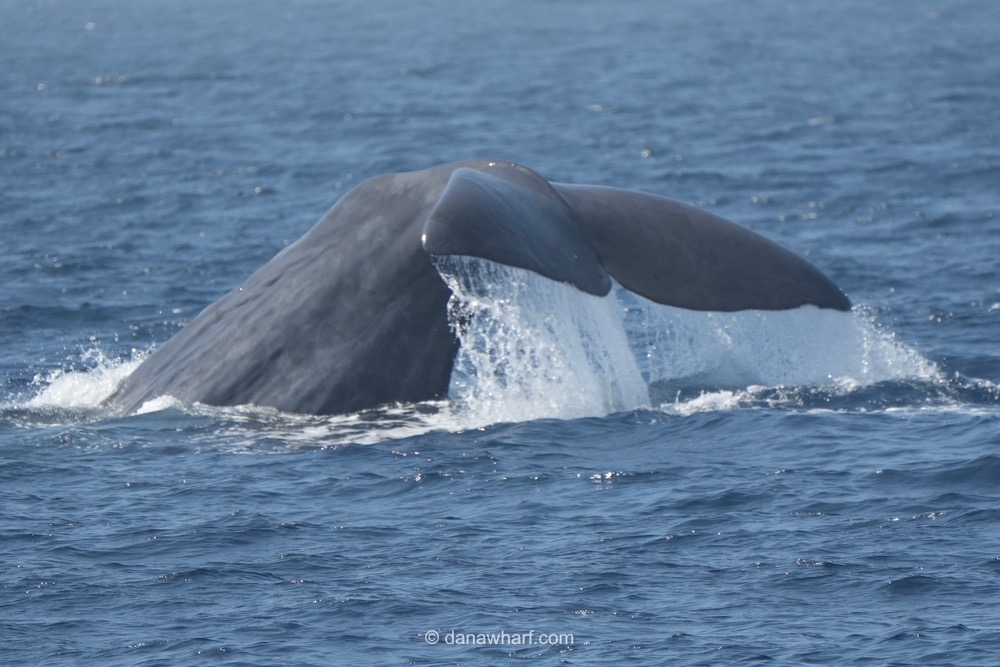Two sperm whales, dubbed Kiwi and Guava, were spotted seven miles off the Dana Point coast on Tuesday, Sept. 16, a rare sighting of the deep-water dwellers.
The sperm whales had been spotted off San Diego in recent weeks, first on Sept. 7 and again Sept. 14, before Capt. Brandon Erdo aboard a Dana Wharf Sportfishing & Whale Watching charter spotted them off Orange County.
Though Donna Kalez has operated for years the charter company her father founded in the 1960s, she had never seen a sperm whale, so she quickly jumped on a boat that was heading out to sea.
“It’s such a bucket-list item and a once-in-a-lifetime experience,” she said. “It’s like a needle in a haystack, it’s so rare.”
Sperm whales can be tough to track, often staying down with long breath holds for 90 minutes.
They typically prefer deep waters, where they can hunt giant squid, said Alisa Schulman-Janiger, research associate and marine biologist with the Natural History Museum of Los Angeles County.
“It’s very, very exciting,” she said of the recent sightings.
Schulman-Janiger is in the early stages of a long-term look at sperm whales off Southern California, tracking trends and sightings based on photos and videos that help to identify the whales based on the markings on the underside of their tails and their humps.
Sometimes, years go by without any sightings, other times they show up several times a year, she said. “But I wouldn’t at all say it’s a regular thing.”
There’s been only a handful of sperm whale sightings in recent years. The last sighting was off the Rancho Palos Verdes coast on Jan. 1.
Local “celebrity” whales get names, such as Double Scoop, who frequented the area from 1984 to 1991. And there was Mango, who was around from 1996 to 2013, she said. Papaya was another that was spotted locally in 2019.
Sperm whales sometimes show up in the region because of a nearshore, deep-water canyon that sits just off the Southern California coastline.
“We’ve had whales off and on throughout the years, but this pair in particular has been sighted several times together,” she said.
Whale-watching boats have been lucky. The whales dive sometimes for more than an hour and usually only spend no more than eight minutes at the surface before resting and going back down, Schulman-Janiger said.
“So it’s a treat to get to see them, because they don’t stay at the surface like a humpback whale, which might be down for six to eight minutes, or a gray whale’s five to eight minutes,” she said. “For sperm whales, they’re down for so long. We only see a fraction of their life at the surface, because they hunt in deep water, and they hold their breath for so long. So it’s really special.”
Sperm whales are found around the world and the juveniles tend to hang out in larger groups, she said. Females tend to stay together with their young, and the males, when they hit sexual maturity, leave family groups and head out on their own or form what she called “bachelor groups.”
Males can get up to 60 feet, while females are around 35 feet in length. They are the largest toothed whale, and their blow comes out of a hole on the side of their heads.
On occasion, sperm whales may visit the area and decide they like it enough to come back year after year, said Schulman-Janiger, especially if they find a food source.
“It will be really interesting to see if this is a long-term thing,” she said.
For the latest sighting, Kalez called it “breathtaking.”
“I think what’s so special about sperm whales is that it’s a whale we don’t see much,” she said. “This is just super rare. I’m hoping sperm whales are going to be more prevalent in our area and we’ll get a chance to see them again, but they are very unpredictable, so you never know.”








